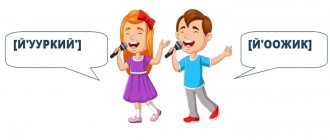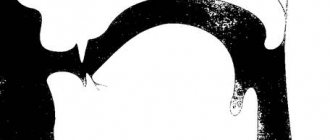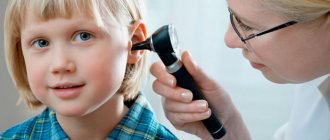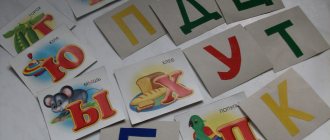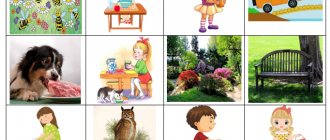Publications on speech therapy
Summary of an open lesson held on April 15, 2010 by teacher-speech therapist Anna Andreevna Mosenkova on the topic “Vowel sounds of the first row” with children attending speech therapy classes at Municipal Educational Institution of Primary School-Kindergarten No. 8 of Traktorozavodsky District of Volgograd
Purpose:
consolidate children's knowledge of the vowel sounds of the first row.
Objectives:
Educational: • consolidate the concept of “vowel sound”; • train children to characterize sound based on articulatory and acoustic characteristics based on an algorithm; • exercise children in identifying and differentiating vowel sounds by ear. Developmental: • develop phonemic hearing and perception; • develop general, fine and articulatory motor skills; • develop auditory and visual attention. Educational: • cultivate respect for a friend’s answers; • cultivate interest in word games.
Equipment:
1. Envelope with a letter; 2. Chest with envelopes; 3. 4 envelopes with tasks; –1st envelope: letter, large sound symbols with handles (A, U, I), pictures depicting children in the forest, a crying baby, a donkey; –2nd envelope: letter; –3rd envelope: 12 pictures, sound symbols A, U, I, O; –4th envelope: letter; 4. Symbols of the sounds A, O, I, U, E, Y for the castle; 5. Bell; 6. Algorithm for characterizing sounds; 7. Sun, flower, grass: 8. Colored clothespins; 9. Medals for children and guests; 10. Tape recorder, disc.
Lesson plan:
1. Organizational moment. Report the topic of the lesson. 2. Analysis and synthesis of combinations of vowel sounds. 3. Physical education minute. Phonetic rhythm. 4. Emphasizing vowel sounds at the beginning of a word. Development of phonemic representations. 5. Physical education minute. Phonetic rhythm. 6. Finger gymnastics. Game with clothespins. 7. Summary of the lesson.
Progress of the lesson:
1. Organizational moment.
Report the topic of the lesson. Speech therapist: Guys!
What is this? Children: Envelope.
Speech therapist: - It says “For the smart and courageous.”
Are you smart and brave? Children: Yes!
Speech therapist: – Then let’s open the letter and read:
“Hello, guys!
I am the king of the Land of Vowel Sounds. In my country there is a large and beautiful castle in which vowel sounds lived, they sang so wonderfully! But the evil sorceress hid them in a chest and turned all the vowel sounds into questions and riddles, they must be guessed in order, but I just can’t do it! Help me bring the castle residents home!” Speech therapist: - Guys, we need to go to the Land of Vowel Sounds and help the King! - Here is the castle that the King wrote to us about and it is really empty, there is no one in it! And next to it there is a chest. – This is the puzzle the sorceress gave us!!! Let's quickly see what's in the chest /together we open the chest/
. Here are the envelopes. Look, there are numbers written on the envelopes! Speech therapist: - Which envelope should we open first?
2. Analysis and synthesis of combinations of vowel sounds.
Speech therapist: - Ira, take the envelope, show me what’s in it.
–This is an assignment from the sorceress, let’s read: “Your favorite vowel sounds love to visit each other.
But what happens when they come to each other?” Speech therapist: - Let's solve this riddle.
Speech therapist: - Sound A came to visit sound U / symbols of vowel sounds are displayed, “holding hands” / Speech therapist: - Marina, what happened? Child: It turned out “AU” / picture/
Speech therapist: – Let’s say together:
“A-a-a-a-u-u-u!”
Speech therapist: -Who screams like that?
Why? Child: Children, when they get lost in the forest.
Speech therapist: -How many vowel sounds did we pronounce?
Child: two.
Speech therapist: -What is the first sound?
Child: And
Speech therapist: -What is the second sound?
Child: U
Speech therapist: - The sound U came to visit the sound A. What happened?
Child: UA
Speech therapist: -Together let’s say “U-u-uA-a-a” Speech therapist: -Who screams like that?
Child: Baby
Speech therapist: -Why?
Child:
/cries, cannot speak, calls his mother/ Speech therapist: -How many vowel sounds did we pronounce?
Child: two.
Speech therapist: -What is the first sound?
Child:
Speech therapist: -What is the second sound?
Child: A
Speech therapist: – Sound And likes to visit sound A. What happens? Child: IA
Speech therapist: -Let’s say “I-i-iA-a-a” together. Speech therapist: -Who says that?
Child: Donkey
Speech therapist: - How many vowel sounds did we pronounce?
Child: two.
Speech therapist: -What is the first sound?
Child: And
Speech therapist: -What is the second sound?
Child: And
Speech therapist: - We guessed the first riddle of the sorceress! Maybe she will return the vowel sound to us? But there is no sound in the envelope... The sorceress is very cunning, she hid it, let's look for the sound. The magic bell will help us with this. Where it rings we will find a vowel sound. /children get up and look for a sound in the classroom, find symbols for 2 sounds /A, U/
.
Well done! Now we will bring back the castle resident! - Ulyana, go to the castle and return the vowel sound to the castle. Name it. Tell us about that sound. Our Memo will help you with this. /the algorithm for the characteristic is set/
.
The child tells the following model with the help of a speech therapist: -When we pronounce the vowel sound A, the lips are wide open.
Teeth wide open. The tongue lies quietly in the mouth, air comes out of the mouth freely. Speech therapist: – What sound?
Child:
Sound A is a vowel. Speech therapist: - Why is it a vowel?
Child:
You can sing it “a-a-a” Speech therapist: - Well done! Sit down!
Speech therapist: - Marina, go to the castle and return the vowel sound to the castle. Name it. Tell us about the sound U. /model/
Speech therapist: - What sound is it?
Child:
The sound U is a vowel.
Speech therapist: Why is it a vowel? Child:
You can sing it ooo Speech therapist: - Well done!
Sit down! Speech therapist: - We have returned 2 vowel sounds, but we still have 4 windows in the castle that are empty. – Marina, open the next envelope. – Let’s read the task: “I will give the vowel sound to the one who knows how to sing songs of vowel sounds.”
Speech therapist: - Guys, show the sorceress what songs you know.
3. Physical education (phonetic rhythm).
Speech therapist: - Let's sing songs about the sounds that we have already found: We get up, push the chairs back. We stand on the green line.
We stood up straight, stretched our arms forward, and got ready: A-A-A /we spread our arms to the sides, sing loudly/. We bring our hands together / quietly sing a-a-a / Repeat 2 times.
Speech therapist: – Let’s sing the little engine’s song: Arms bent at chest level, palms turned away from you. We pronounce the sound U and straighten our arms forward and down.
Speech therapist: - Well done! Now the sorceress will definitely give us another vowel sound. The bell will help us with this. - Found it, well done! What sound is this? Child:
Vowel sound And Speech therapist: -Ira, go to the castle and return the sound to the castle.
Tell me about that sound. /according to the algorithm/
– Well done! Sit down!
4. Emphasizing stressed vowel sounds at the beginning of words. Development of phonemic representations.
Speech therapist: - Let's open the next envelope and read the riddle from the sorceress:
“Guess what vowel sound is hidden in the words in the pictures.”
Speech therapist: - What a cunning sorceress, she gave a complex riddle, but we will guess it too!
/Cards with pictures are displayed one by one/
Speech therapist: - Look at the pictures and listen to the words: Anya, stork, aster.
Speech therapist: - What vowel sound is hidden in these words? Child:
The vowel sound A is hidden in these words. Speech therapist: - Well done! Choose which symbol should be put in the window, Ulyana.
Likewise with the words:
– Iris, needles, willow. - Duck, ear, fishing rod. – Cloud, wasps, vegetables.
Speech therapist: - You guessed the riddle! Smart girls! Oh, look, the vowel sound turned out to be mine, oh, and a cunning sorceress? -Marina, go to the castle and return the vowel sound to the castle. What sound did the sorceress give us? Child:
Vowel sound O. Speech therapist: – Tell us about it /according to the algorithm/.
Speech therapist: - We have the last envelope left. Marina, open it, let’s read: “You only know 2 songs with sounds, but there are many of them!
If you sing songs about the other sounds, then I will give you the last vowel sound! Ha-Ha-Ha!” Speech therapist: -Guys, I think you can easily cope with this task!
5. Physical education minute. Phonetic rhythm.
We get up and move our chairs. We stand on the green line. Speech therapist: - Let's show the sorceress Flowers: “The flowers are closed” - the children take the starting position: squat down, fold their arms, pressing their chin to their chest. “Bloomed” we slowly stand up, pronouncing the vowel o-o-o, while simultaneously raising our arms up through the sides and connecting them into a ring above our heads.
“The flowers are closed” starting position. “Bloomed”, rejoiced at the sun - joyfully, with a smile, they raise their hands high above their heads (fingers clenched into a fist, index pointing upward). Standing on your toes, we stretch up and say i-i-i.
Hands down. When pronouncing the vowel uh-uh, children smoothly bend their arms at the elbows, raising their hands to shoulder level, elbows down, while shaking their heads with a reproachful tone.
The arms are bent at chest level, the fingers are clenched into fists, and the elbows are directed to the sides. When pronouncing the vowel ы-ы-ы, children forcefully move their arms bent at the elbows to the sides (“stretch the spring”).
Speech therapist: - Smart girls, you have completed all the tasks of the evil sorceress and now she must give us the last sounds, let's find them! The bell is silent and does not tell us. Or maybe the sorceress gave vowel sounds to our guests? Look carefully. Speech therapist: - Found it! Marina, what vowel sound did you find? Take him back to the castle. Tell about him. /according to the algorithm/ – Well done! Sit down! Speech therapist: - Ira, what sound did you find, return it to the castle, tell us about it. -Well done! Sit down!
Speech therapist: - Look, we returned all the inhabitants to the castle. -What vowel sounds live on the first floor? -What sound lives under the vowel A? -What sound lives above the sound Y? -What color is the castle in which the vowel sounds live? Child:
Red Speech therapist: – Why?
Child:
Vowel sounds live in it. Speech therapist: The vowel sound is always red. Let's repeat it together.
6. Finger gymnastics. Game with clothespins.
Speech therapist: - We returned all the vowel sounds home, but they are still sad, we can cheer them up with the help of the sun, grass and flowers.
But what are they missing? Children:
To the sun - rays, to a flower - petals, to grass - blades of grass. Speech therapist: - Let's do this with the help of colored clothespins. /attach to the lock/
7. Lesson summary /music!/
-Look how beautiful, sunny, joyful it has become in the Land of Vowel Sounds.
Our journey is over, but the King wants to thank you for your help and gives everyone medals with vowel sounds so that you don’t forget about them and enjoy their singing. – Guys, give medals to our guests in memory of our journey. /the speech therapist puts medals on the children, and the children give them to the guests/
.
CHILDHOOD GUIDE
Summary of a speech therapy lesson on the topic “Vowel sounds” for children of senior preschool age with OHP
Olga Anatolyevna Kharitonova, teacher-speech therapist of MBDOU No. 14, Yartsevo, Smolensk region.
Objectives: - to develop the ability to hear and identify vowels of the first row; - develop long continuous oral exhalation; - develop visual and auditory attention and memory, tactile sensations; - cultivate a caring attitude towards each other.
Equipment: mirrors; subject pictures; “magic” shoes (knitted booties); plastic vowels; sound house; cards with a series of letters (vowels and consonants).
Articulation gymnastics Tale of a cheerful tongue Teacher-speech therapist: Once upon a time there lived a little tongue in his house. The doors in the house opened and closed. (Children open and close their mouths). One day, the tongue came out of the house, looked to the right, then to the left (do the “Clock” exercise), then reached up to the sun and lay down on the porch (the “Spatula” exercise). Suddenly a breeze blew, the tongue quivered (exercise “Arrow”), hid in the house and closed the house and closed the door behind itself. At home, the tongue gave the kitten milk. The kitten lapped up the milk (exercise “Delicious Jam”), then licked its lips and yawned sweetly. The tongue looked at the clock, it was ticking: tick-tock (exercise “Clock”). The kitten stretched and went to bed. And outside, the sun hid behind the clouds, it became cool, and an angry “z-z-z” was heard. Who do you think it was? Children: Mosquito. Speech therapist teacher: The big mosquito sang: z-z-z, and the little one sang along with him: z΄ - z΄ - z΄.
Gymnastics for hands (su-jok) I will squeeze the ball tightly and change my palm. “Hello, my favorite ball!” - Each finger will say in the morning. He hugs the ball tightly and doesn’t let it go anywhere. Only gives it to his brother: Brother takes the ball from his brother. Two little goats butted the ball and gave it to the other kids. I roll circles on the table (hand), I don’t let go from under my hands. I swing it back and forth, right and left - as I want. Each finger can dance on the ball. I knead the ball with my finger, I roll the ball along my fingers. My ball doesn’t rest – it walks between my fingers. I'll play football and score a goal in my palm. Top left, bottom right - I roll him bravo. I’ll turn it around, and you check – it’s on the top right now!
Children sit in a circle on the carpet and are given “magic shoes” containing plastic vowel letters. Speech therapist teacher: Close your eyes and feel the shoe. What was hidden in it? Children: Vowel sounds [a], [o], [u], [e], [s]. Speech therapist teacher: What do you think the topic of our lesson will be called? Children: Vowel sounds and letters.
Game "Fly, butterfly!" Goal: development of long-term continuous oral exhalation. Equipment: 2-3 bright paper butterflies. Progress of the game: The teacher shows the child butterflies and invites them to play with them. - Look how beautiful the colorful butterflies are! Let's see if they can fly. The teacher blows on butterflies. - Look, they're flying! How alive! Now you try to blow. Which butterfly will fly farthest? You can blow for no more than 10 seconds with pauses to avoid dizziness.
Game “Guess the Sound” The speech therapist teacher shows the articulation of vowel sounds, and the children name them in chorus.
Logorhythmics Children stand in a semicircle and sing vowels, accompanying the movement: [a] – arms smoothly spread to the sides; [o] – arms are raised up in the form of an oval; [y] – arms are extended forward, fingers clenched into a fist; the index finger is pulled forward; [and] – straight arms are raised up, fingers are clenched into a fist, the index finger is pulled forward; [s] - fingers are clenched into a fist, hands are bent under the chin, fists are “turned out.”
Game “The most attentive and fastest” Children receive cards. Speech therapist teacher: Look carefully at the letters. Cross out only the vowels: AVSHBEUKSHSYFTPEKOTIENUAM. The children do it. Speech therapist teacher: Look at the crossed out letters. Which one is the odd one out? Why? Children: Vowel and, because she is from the second row.
Game “Scattered Pictures” “Houses” with the vowels a, o, u, s are laid out around the room. Children find them and name them. Then they draw out four cards with pictures (house, table, poppy, beetle, cancer, smoke, cat...). Speech therapist teacher: You need to isolate the vowel sound from the name of the picture and “place” it in your house. Children perform by checking the correct placement of the pictures. Now remember and name the pictures that you laid out. The children do it.
Game “Guess what I’ll write” (dermolexia technique) Children stand in a circle. Speech therapist teacher: Close your eyes, stretch your palm forward. What letter did I write? (He approaches everyone and “writes” a letter on his palm with his finger.) Now open your eyes and find a picture on the carpet whose name contains this sound, and stand on it. The children do it. Let's check. Everyone names their sound and picture, and the rest, if they agree, clap their hands. Summary of the lesson Speech therapist teacher: Children, what have you learned to do?
What did you like? The children answer. On vacation with the letters Sounds T - D The journey of a grain of sand. Sounds [P-P']. Letter P Magic sounds of a barrel organ >
How to pronounce vowel sounds so that your speech sounds clear
In Russian phonetics there are 43 sounds - 37 consonants and only 6 vowels. Consonant sounds are responsible for information - if we say “thank you” or “please”, everyone will understand that this means “thank you” and “please”. If we say “aio” or “oauya”, then it will be an incomprehensible set of sounds, the meaning of which is incomprehensible even in context. If there are few sounds in a language and they do not have any informational load, does that mean they are not so important? Not at all, vowel sounds are sometimes more important than consonants:
- thanks to vowel sounds, spoken speech has intonation
- With the help of vowels we can divide speech into syllables
- vowel sounds help emphasize words and make speech dynamic
- without vowel sounds the existence of logical stress is impossible
- by the pronunciation of vowels, we determine where a person comes from
- It is the vowel sounds that make oral speech clear and intelligible
Consonant sounds are not realized independently in speech. The lips always take the form of vowels even before we begin to pronounce any consonant sound. It is interesting that for people who, for various reasons, have lost their vocal cords or muscles, a large number of methods and devices have been developed for the formation of vowel sounds. Even in the text, the absence of vowels makes it difficult to understand the meaning.
“turn darkness into the light of slavery” - ten consonants have three vowels, and in the Russian language you can write just as sweetly as in Italian... Radishchev A. N., Journey from St. Petersburg to Moscow, 1790
Among speech therapists there is a rule “To achieve good diction and correct pronunciation of consonants, pay attention to vowels.” Therefore, as a practicing speech therapist with experience, I want to share with you several techniques that I use in my work. They will help you make your speech clear and easy:
- Always pronounce all vowels in a word, especially stressed ones - this will give your speech expressiveness and clarity.
- Practice the correct pronunciation of consonant sounds along with vowels - this will help you achieve the right effect faster.
- The strongest vowel sounds that help achieve clear diction are the Y sound and the E sound. We unwittingly add them when several consonants follow in a row in a word, for example, “Yaroslavl.” And we add the sound E to speech when we want to show that we are looking for a suitable word for our statement.
- The word “vowel” in Russian is used not only to designate a group of sounds. Public information is information that is available to society without restrictions. In pre-revolutionary Russia, deputies were called “glasny” - Glasny of the City Duma.
Exercises
Read combinations of sounds and words aloud, emphasizing the emphasis in your voice. aouy - you aouy - we aouy - you // aouy - smoke aouy - bull aouy - cheese // aouy - alas aouy - was aouy - son //
Name what is shown in the pictures as quickly as possible. Remember that the main emphasis should be on vowel sounds.
ZOYA IN THE DIAMOND POSE - ZINA IN THE SNAKE POSITION
